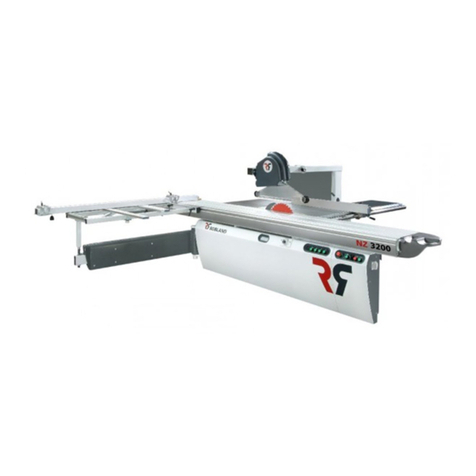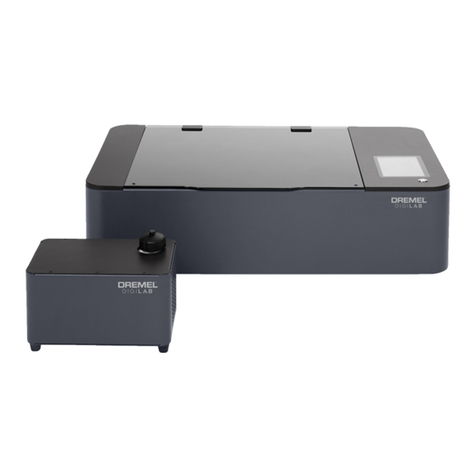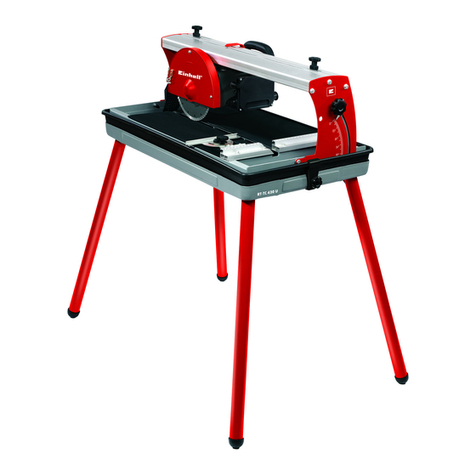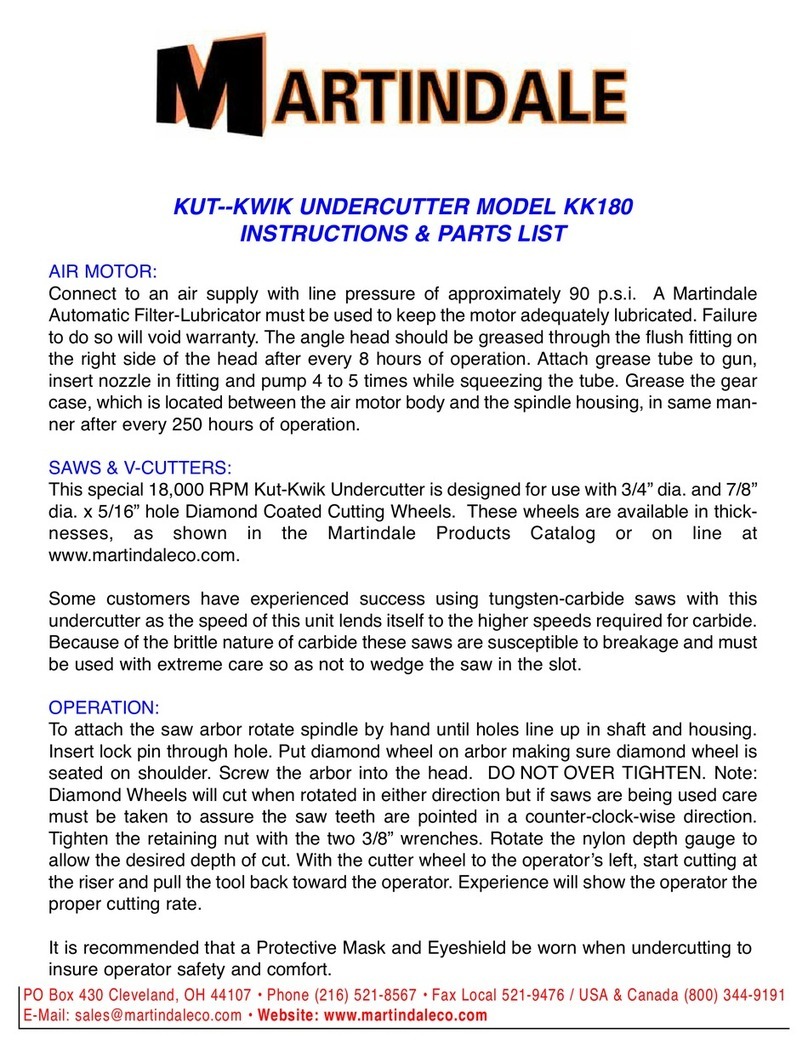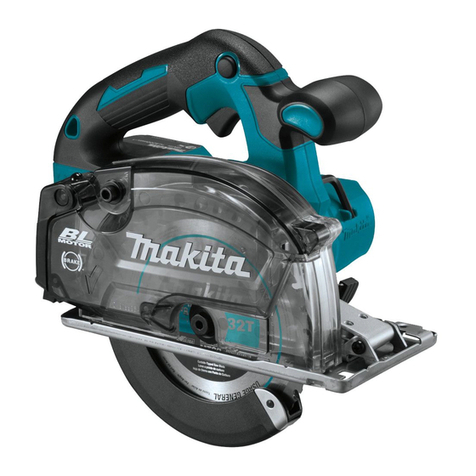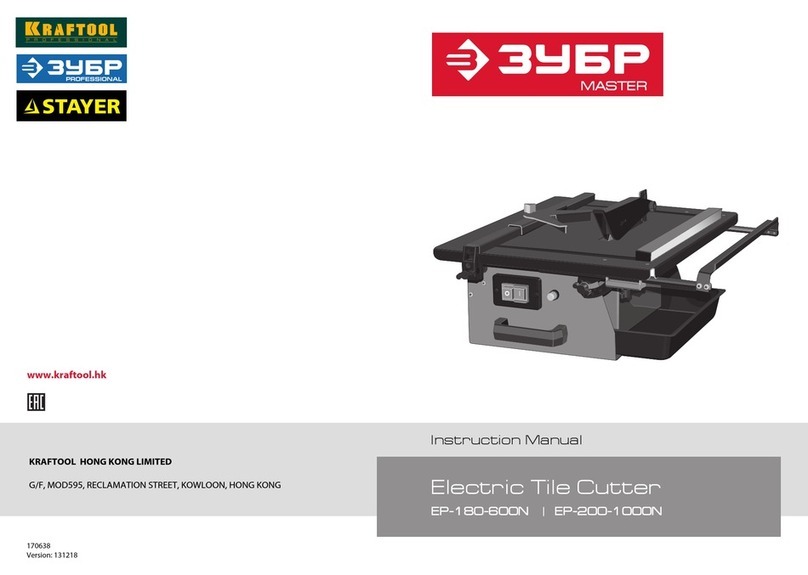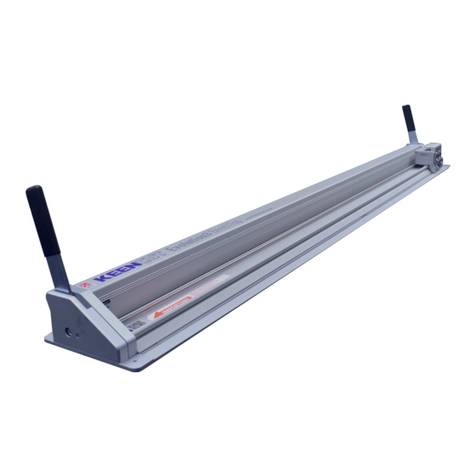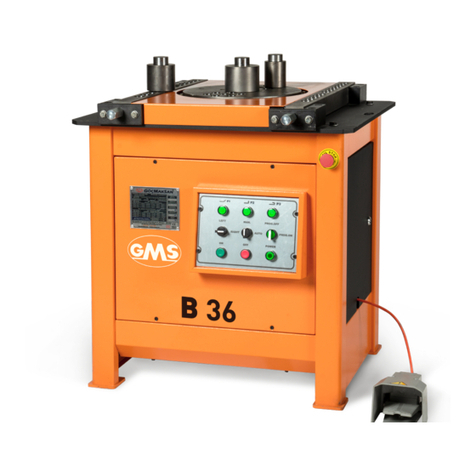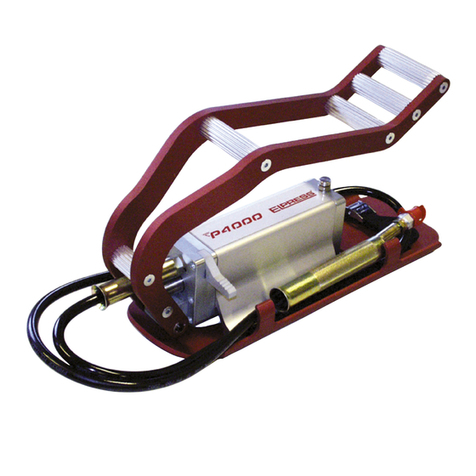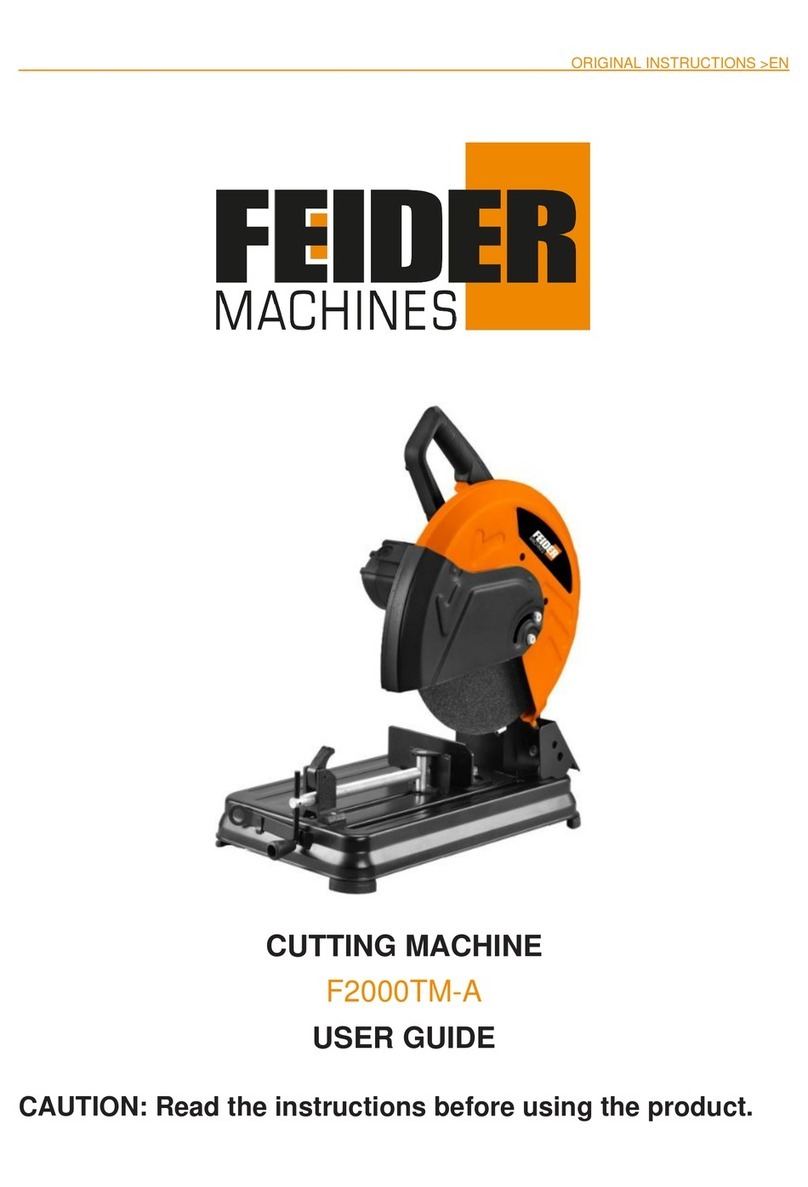Robland Silver Series User manual

Robland BVBA
Kolvestraat 44
BE-8000 Brugge
T+32 50 458 925
F+32 50 458 927
www.robland.com
line
Manual

–English
Silverline - PS 3200 V0713 1
Index
CE declaration 2
Important instructions when ordering spare parts 3
Attention 3
Safety and maintenance instructions 3
Handling of tools 4
Normal and prohibited use 5
Technical Data 5
Electrical Connection 5
Mounting of the sliding table 5
Starting up the machine 6
Setting an axis 8
Park position 9
Setting saw blade 10
Setting the groove cutter 11
Cutting lists 12
Settings 13
Language choise 13
Settings of time and date 13
Select working in MM or Inch 13
Starting up the machine 14
Calibration of the scale on the parallel fence 14
Option A5216: Retro-t digital read-out for parallel fence 15
Mounting and adjusting the riving knife 17
Lower sawblade cover 17
Blocking the sliding table 18
Mounting of the cross-cut table 19
Mounting of the cross-cut fence 19
Adjusting the cross-cut fence 20
Using the sawguard 21
Maintenance of the machine 22
Problems: causes and solutions 22
Adjusting the brake of the saw motor 23
Electrical parts list PS 24
Electrical Diagrams 26
Exploded views 29

–English
2Silverline - PS 3200 V0713

–English
Silverline - PS 3200 V0713 3
Important instructions
when ordering spare parts
Always mention the following items on your order:
– Type of machine
– Serial number from manual
– Part number and quantity
– Your reference and correct phone and fax number
Attention
Working with woodworking machines can be extremely dangerous if the safety instructions are not
followed.
It is recommended you systematically use the safety equipment installed on the machine.
Safety and maintenance instructions
Woodworking with machinery is a pleasant job that will give you a lot of satisfaction. Nevertheless,
working with a machine requires constant attention and care. Therefore, for your own safety, pay
attention to the instructions summarised in this chapter.
– The machine can only be used safely if the operator strictly follows the operating and safety
– instructions.
– It is absolutely essential to read this manual before using the machine so you know how the
machine works and what its limitations are.
– Always make sure that all safety devices are tted to the machine and that the machine is
connected to a dust extraction system.
– Provide sufcient space around the machine and good lighting in the workshop.
– When changing the tools or when doing a maintenance job, the machine must always be
disconnected from its power supply.
– Knives and tools which are not correctly sharpened or are in bad condition not only diminish the
quality of the work, but also increase the risk of accidents.
– Always wear suitable clothing. Loose or torn clothes are very dangerous.
– Keep children away from the machine and the workshop.
– To avoid damaging your hearing we recommend you wear ear protection when working with the
machine.
– When cutting narrow pieces always use a push stick. When damaged, replace the push stick at
once.
– When cutting round workpieces, always make sure the workpiece is secured against slipping.
– Always use adapted jigs and templates and saw blades adapted to the work being carried out.
– Carefully read the recommendations for adjusting the brake of the main saw brake motor.
– Make sure all periodic maintenance work is done on time. These maintenance works may only
be carried out with the machine disconnected from the main power supply line thus rendering it
impossible to start the machine involuntarily.
– Read carefully the instructions for cleaning the machine, clean only with the machine
disconnected from it’s power supply line.
– Test on a weekly basis the following electrical components: emergency stops buttons, the safety
switchs on the saw unit and test if the machine can be started-up with open doors.
– Test on a weekly basis if the run down time of the saw motor brake does not exeed the 10
seconds.
– Please read the noise emmision values in the manual.
– Always wear ear protection when operating the machine.

–English
4Silverline - PS 3200 V0713
Handling of tools
Always wear safety gloves when handling saw blades thus avoiding severe injury to the hands. Please
bear in mind that even blunt tools can cause serious damage.
Normal and prohibited use
The panelsaw is designed for the following work and is equipped with protective devices for
these processes only. It is not designed to work materials such as ferrous or non-ferrous metals, work
different from that stated below is prohibited.
– Ripping with the parallel saw fence with/without the sawblade tilted and the fence upright or in the
low
– position.
– Right-angled or mitre cuts with the 90° fence mounted to the sliding table with tilted or vertical
– sawblade.
– Cross-cutting workpieces using the adjustable stop on the 90° fence.
– Cutting panels or solid wood on the sliding table.
PROHIBITED USE
Following tasks are prohibited on the panelsaw :
– submerged cuts by removing the riving knife and/or guard;
– all types of cuts without using the table saw fence, the 90° fence or sliding table;
– Cutting large workpieces that exceed the machine capacity without using aids such as roller
supports.
REMAINING RISKS
Main risks on the panelsaw are :
– unintentional contact of the hand with the running sawblade;
– workpiece kickback
– tipping of the workpiece due to insufcient support.
NOISE REDUCTION
Main risks on the panelsaw are :
– The type and condition of the sawblade is important in keeping the noise level as low as possible.
– The material and the position of the safety devices are important in reducing the noise level.
– Using the correct speed of the sawblade for the type of material will reduce the noise level as well.
– The above does not negate the fact that extra safety equipment such as ear protection must be
used.

–English
Silverline - PS 3200 V0713 5
Technical Data
Saw
Diameter saw blade and bore 450 x 30 mm
Diameter saw blade min. 199 mm
Cutting depth at 90° / 45° 150 mm / 108 mm
R.p.m. 3000 / 4000 / 5000
Sawblade tilting 90° - 45°
Cutting width parallel fence 1300 / 1525 mm
Cutting length 3200 (option 3800) mm
Dimensions cast iron table 985 x 710
Dimensions saw table extension 885 x 1125
Dimensions right hand table extension 1000 x 710
Dimensions sliding table 3200 x 420 (option 3800) mm
Dimensions cross-cut table 760 x 1505
Length cross-cut fence 2200 (telescopes/ teleskopisch 3360 mm)
Scoring saw
Diameter saw blade and bore 125 x 20 mm
Cutting depth with 120 mm diameter blade 3,5 mm
R.p.m. 8200
Scoring saw motor power 0,94 kW (1,3 PS/hp)
Equipment
Dust suction ports 120 + 80 mm
Mitre cross-cut fence on the cross-cut table Standard/standard
Mitre fence and woodclamp on sliding table Standard/standard
Extra support table and fence Standard/standard
Digital read-out on both flip stops of the fence Option / option
Roller suppport Option / option

–English
6Silverline - PS 3200 V0713
Electrical connection (Fig.3)
The electrical connection must be carried out by a qualied electrician who is able to calculate exactly
the required wire cross-section and capacity of the workshop fuses.
Check that the main voltage of the machine corresponds with the voltage supply to your workshop.
Now open the electrical switch panel and introduce the cable. Connect the 3 phases to the
terminals on the connection block marked L1, L2, L3. If there is a neutral conductor (blue)
it must be connected to the terminal N.
Connect the earth wire (green-yellow) to the terminal marked with the earth symbol PE.
Attention :
- Check rst if the saw spindle runs freely and if all safety devices are tted before starting the
machine.
- If the direction of rotation of the sawblade is not correct, the wires L1 and L2 must be exchanged
(clockwise direction of the spindle is correct).
- For safety reasons this must only be done without the sawblade on the spindle !
thermAl overloAds
The machine has overload protections on both saw and scoring motors. Should the motor be shut-off
by one of these protectors, it is necessary to wait a few minutes untill the overload has cooled down.
Mounting of the sliding table (Fig.4)
To obtain a good arrangement and function of the sliding table; it is vital that the machine is put on a
right level in both directions, with the help of a level, before putting the sliding table on the machine.
All the adjustments and arrangements are done in the factory. Simply put the table onto the frame with
the two lateral adjustment bolts (1) into the two lugs of the frame. Be sure that the girder rests well in
the height adjustment bolts. Now place the 4 big Allen bolts (3) and tighten well. In order to obtain a
good movement of the wood or the sliding table, the sliding table is set near to 2 mm above the sawing
table. The parallelism between the principal blade and the sliding table, can be corrected by using 2
bolts. After the adjustment, the 4 bolts need to be tightened well with a Torque wrench with a value of
7 kg. The adjustment in height of the sliding table can be done by using 8 bolts (2) but always with the
big bolts closed.
The
Fig.3 Fig.4

–English
Silverline - PS 3200 V0713 7
Starting up the machine
1. stArting up the mAchine
Turn the mains on-off switch to “ON”
After the start procedure is completed this screen
will appear.
Now push the start button in order to start the
reference procedure.
All 3 axis will now start moving to their reference
points.
In order to speed-up this procedure, it is best to use
the “Park” function at the end of the working day.
(see 2.2)
During reference procedure you will see this screen.
As soon as one axis has reached the reference
point an “V” will occur.
As soon as all 3 axis have reached their reference
point, the main screen will appear.
Startscreen
Screen reference
Park function
Menu functions
Selection of the axis
Information about time, diameter of the saw blade in function on the machine and R.P.M of the saw blade.
Main screen

–English
8Silverline - PS 3200 V0713
2.1 setting An Axis
Select an axis by pushing a eld.
The frame of the buton lights up in fat as conrmation
this buton has been selected.
Each axis has a selection screen.
After conrming you get the main screen
Now you will see an arrow appear and the start buton starts ashing. The axis starts moving as soon as the
start button is pushed. The values of one or more axis can be adjusted at the same time.
Desired value
Current value
value
max. value
Selected axis
Return
Conrm
min. value
The selection screen has a calculator function
On the left side you
see the list of the 4
last used values
Selection screen

–English
Silverline - PS 3200 V0713 9
2.2 pArk position
3.1 menu screen
This function enables the quick start-up and reference procedure of the machine.
You get the choise between only parallel fence park position or all 3 axis.
Park button
Only park parallel fence
Park all 3 axis
MENU button

–English
10 Silverline - PS 3200 V0713
3.1.1 setting sAw blAde
First a warning screen appears.
The fence will be moved away from the saw blade,
set the saw blade at 90° and at its maximum height.
Then the brake on the saw motor will be released.
You can pre-program 4 saw blades.
By selecting the eld you can select the saw blade.
By pushing the value eld under diameter, B or b
you can change the value.
The machine will take in account these stored values.
* * when, after sharpening the saw blade, these values have changed, you can adapt these
values. The machine will aslo correct the cuting depth.
* * The difference between the saw tooth (B) and the main saw blade body (b) is important for
compensating the parallel fence.
Setting groove cutter
Setting saw blade
Settings
Height calibration
Cutting lists
Tilting parallel fence
Calibration parallel fence
Menu screen
Saw blade menu screen

–English
Silverline - PS 3200 V0713 11
3.1.2 setting the groove cutter
After conrming your choise of the saw blade, you
will be asked an extra control of the R.P.M.
The machine shows the current R.P.M., you must
conrm this is the right speed for this saw blade.
1 groove cutter can be stored the same way as a saw
blade.
Once the groove cutter selected, the whole saw unit
can only be moved up-and down.
It is impossible to groove at an angle.
This procedure is the same as for changing the saw blade. The differences are:
The table insert has to be taken away in order to mount the groove cutter tool.
The maximum dimensions of this tool is 16 mm wide and a body thickness of 12 mm.
The high lighted symbol indicates which value you
change, in this case the saw blade diameter
Min. and max. value
of the saw blade
Numeric eld
Return
Conrm
Screen saw blade settings

–English
12 Silverline - PS 3200 V0713
By pushing the eld after the number, each cutting
list can be given a name.
3.1.3 cutting lists
By selecting the number, you can enter the screen cutting list.
There are 100 x 5 cuting lists
Possiblity to name each cutting list
Remove
Return
Conrm
Menu screen cuting lists
Go to next or
previous cuting list
Return
Conrm
Selected cuting list
To change the value, push the value.
Changes are made in the setting a measurement screen (see 2.1)
Screen cutting list

–English
Silverline - PS 3200 V0713 13
3.1.4 settings
3.1.4.1 lAnguAge choise
3.1.4.2 settings of time And dAte
3.1.4.3 select working in mm or inch
Choose language and conrm.
First select the eld
Choose day, date, … with arrows < and >.
Change the value with the arrows up-and down.
Conrm in order to store the value.
Select the wanted system and conrm in order to
store.
Setup numeric control
3 different axis
Settings of time and date
Setup
Open or close motor brake
Return
Selection
MM or Inch
Language menu

–English
14 Silverline - PS 3200 V0713
Starting up the machine (PS Version)
Turn the main switch (6.1) to “1” and ensure that the star-delta switch (4) is put in position “star”.
- To start the main saw motor push the start button (3).
- After about 8 seconds put the star-delta switch (4) in position “delta”. This time delay is needed to
let the motor gain its full speed before switching over to “delta”. When you forget to switch over from
“star” to “delta”, the motor will reach its full speed but will have no power and will be damaged.
- The scorer motor is started by pushing the start button (6); this is only possible with the main saw
motor running.
- By pushing the stop button (5) the scorer motor is stopped, when the emergency stop button (1) is
pushed both motors are stopped.
- The main saw motor is equipped with an automatic brake which slows down the motor within 10
seconds as soon as the machine is shut off.
wArning:
When the machine access door is open, it is impossible to start up the machine.
The RPM indicator lights at the front of the main switch panel show the speed of the saw
spindle as soon as the machine is switched on with the main switch (1).
All fuses can be found inside the electrical switch panel and each time this panel is opened the
machine has to be disconnected from its power supply.
Calibration of the scale on
the parallel fence (Fig.25)
Each time a new sawblade is tted the parallel fence scale has to be calibrated to the new
sawblade.
By cutting a sample and measuring its exact length, the scale can be adjusted so that the exact
measure corresponds with the front side of the fence.
After the screw (1) has been loosened the scale can be adjusted. To avoid the fence contacting the
sawblade while it is revolving, the stop ring (2) has to be adjusted.
Slide the fence to about 10 mm from the sawblade.
Now slide the stopring (2) across the round guide bar (3) until it comes up against the
casting of the fence. Tighten the lock screw on the stop ring.
Fig.5 Fig.6

–English
Silverline - PS 3200 V0713 15
Option A5216: Retro-t digital read-out
for parallel fence
Mounting instructions for panel saw Z serie
Put the digital read-out onto the parallel fence support block using the 2 holes already
drilled. On older machines these 2 holes need to be drilled.
Now put the alu prole holding the magnetic strip onto the saw table at 1 mm below the table’s front
edge.
Make sure the sensor is put in the middle of the magnetic strip, and the distance between strip and
sensor is set at 0,5 mm maximum.
Make sure the sensor stays at 0,5 mm over the entire lenght of the magnetic strip.
0,5 max

–English
16 Silverline - PS 3200 V0713
Put the digital read-out onto the parallel fence support block using the 2 holes already
drilled. On older machines these 2 holes need to be drilled.
Now put the alu prole holding the magnetic strip onto the saw table at 1 mm below the table’s front
edge.
Make sure the sensor is put in the middle of the magnetic strip, and the distance between strip and
sensor is set at 0,5 mm maximum.
Make sure the sensor stays at 0,5 mm over the entire lenght of the magnetic strip.
The little table extension as supplied, makes it possible as before to cut upto 1380 mm.
It will also act as a protection for the magnetic tape.

–English
Silverline - PS 3200 V0713 17
Mounting and adjusting the riving knife
(Fig.21)
The machine is equipped with 2 riving knives adapted for the use of saw blade diameters 300/350/400
and 450 mm.
The riving knife can adjusted in both vertical and horizontal direction.
When adjusting the riving knife, always make sure the gap between saw blade and riving knife is set
between 3 and 8 mm.
Adjustment is done as follows: unlock the central bolt (1) and move the riving knife.
Adjust the riving knife in height assuring the upper edge never exceeds the base of the highest tooth in
use by 3 mm.
The 4 adjustment grub screws (2) are used for the exact setting of the riving knife in line with the saw
blade..
After adjustment is done, always lock the central bolt (1) with a torque of 60 Nm.
Never remove the riving knife; kickbacks are severe and very dangerous!
Lower sawblade cover
The lower sawblade cover has an extra safety device which will protect the user during sawblade
changing.
To open the lower cover, the upper part of the sliding table has to be slid to the back.
Now the two locks can be opened at both sides of the cover and the safety lever can be pulled up.
Only now can the sawblade cover be opened.
Fig.21

–English
18 Silverline - PS 3200 V0713
Fig.15 Fig.16
Not good
Good
1. The scorer sawblade is below level and does not work properly. There will be chipping on the
interior side.
2. The scorer sawblade is to far up, there will not be chipping but 2 excessive grooves.
3. The scorer sawblade is not aligned properly to the main sawblade. There will be a border on one
side and a waste on the other.
4. Correct setting of the scorer saw
It would be good to t the height of the blade only at a height necessary for an incision that would
cross exactly the laminated layer or overlay.
In case of extended softwood processing without use of the scorer sawblade, it is recommended to
remove the blade to avoid damage and dust projected by the main sawblade.
Blocking the sliding table (Fig.14)
- The sliding table can be blocked in two positions and with one block-system. This is vital for
example by loading of the boards or cutting along the parallel guide. The system is located on the
front-side of the sliding table. Pull the button (1) in your direction and turn to the right to liberate
the table. Pull the sliding table till end, the table will be blocked automatically when arriving in the
exact position. Continue this way to start working.
- When several movements are repeated consecutively,
it is possible that the bearing cage between the two
proles moves a little bit. We can note this as well by
a reducing travelling distance of the sliding table. To
proceed and achieve the normal travelling distance of the
sliding table, you can adapt the position of the bearing
cage: simply push the table with a few short, light pushes
against the buffer stop at the end of the sliding table until
the position of the ball carrier is adjusted and the table
can be moved again along its full stroke.
Attention: cleaning and maintenance of the sliding table
It is vital to regularly blow away the saw- and other dust,
collected between the sliding table and the bearing cage.
Push the sliding table to the end, to get a better reach
towards the rails, the bearing cage and gliding tracks.
Oil serves to lubricate the sliding rails and is an extra
guarantee of good use and function. Fig.14

–English
Silverline - PS 3200 V0713 19
Mounting of the cross-cut table (Fig.17)
The cross-cut table can be mounted on the sliding table as follows: make sure that both mounting
brackets are well placed in the lateral groove of the sliding table.
The locking itself is done with the two locking handles (1). Make sure the cross-cut table rests well on
the vertical post of the telescopic arm. The machine serves only to put the cross-cut table at the back
of the sliding table, with a maximum at the centre.
The cross-cut table and fence are factory set at 90° to the saw blade but if for some reason this is not
the case and not exact anymore, the 90° angle setting adjustment is done by loosening the 4 bolts
(2) and shifting the complete cross-cut table. Make sure these 4 bolts are well tightened after the
adjustment is done.
Mounting of the cross-cut fence (Fig.18)
The cross-cut fence has 2 positioning pins which locate in 2 precision holes in the cross-cut table.
Make sure the fence is placed fully down on to the table, put the locking knobs in place and tighten
them well.
The two adjustment grub screws in the left side bore assure the correct, play free, position of the fence
and do not serve as 90° angle setting, this adjustment is done as described above by shifting the
complete cross-cut table (g. 17.2).
The cross-cut fence can be used on 2 positions: at the front, or back side of the cross-cut table.
Fig.17
Fig.18
This manual suits for next models
1
Table of contents
Other Robland Cutter manuals
